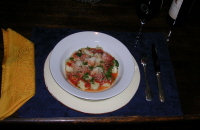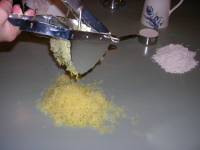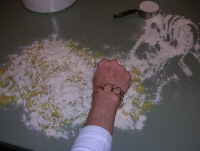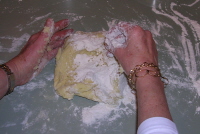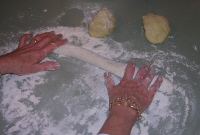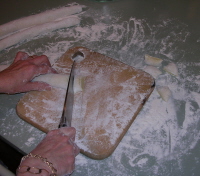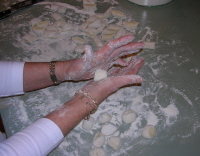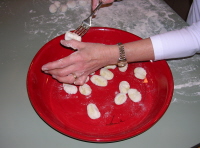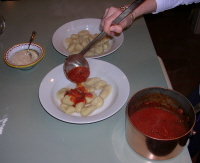| CLASSIC pasta | gnocchi - how to make them | |||
|
|
The goal in making the superb gnocchi is to keep it as light as possible. Here are some basic rules and guidelines before we start: >Moisture is the enemy. Get rid of as much of it as possible. Less moisture means using less flour; which means the gnocchi will be lighter. >Use the proper potato: regular boiling potatoes. Not new potatoes, nor baking. Yukon gold, russet, and yellow fin are fine. >Do not overcook the potato. You have to test for doneness to see if it is tender. You can use a fork for this test, but we prefer using the thin wire of a cake tester. Do not test the potato too often (lets in moisture). The potato cooking should take about 40 minutes. >Puree (or rice) the potatoes while they are still quite warm. >You must cook or freeze the gnocchi immediately on making them. Don't wait. With your potato ricer or food mill at the ready, here we go: Ingredients (alla parigina):
Put the potatoes, with skins, in a large pot with plenty of water. Bring to a boil and cook until the potatoes are tender. (about forty minutes).
When done, drain them, put on your rubber gloves (the potatoes should be hot), scrape the peels off the potatoes. Puree them through a food mill or through a potato ricer, and spread them onto a work surface (let the steam rise a bit). In a small bowl, beat the egg, add a touch of salt and a dash of white (or black) pepper, and blend. (not shown). Shape the cold, pureed potatoes in a small mound with a hollow in the middle (like fresh pasta preparation). Put the egg mixture in the hollow and start melding the potato and egg together.
Gradually add flour to the mixture, shaping and melding as you go. Add as much flour as necessary to give you a firm but still moist dough. As you are melding the dough and flour, regularly scrape up little pieces of dough stuck to the board and get them back into the basic mixture.
Keep dusting your hands and the work surface to keep the dough from sticking. Stop adding dough when the mixture has become smooth but still sticky. This process should take about eight to ten minutes. Do not make the process too long: the longer it goes means more flour which means heavier gnocchi.
Divide the dough into three parts. With the palms of the hands, roll each piece into a rope of dough, like a sausage, (as above) a little less than an inch thick.
Cut the rope crosswise into one-half to three-quarters of an inch pieces.
Sprinkle the pieces with flour (continually dusting your hands and the surface with flour) and roll each piece in the palms of your hands into a little ball.
Now for the signature move. Hold a fork in one hand. Put flour on the index finger of your other hand. Take a ball of dough, with the tip of your index finger hold the ball against the tines of the fork (held concave) and press the dough gently into the fork, rolling it downward along the tines. With amazing dexterity, flip the ball of dough off the fork away from the tip. You should now have a dumpling, with a ridged surface on one side and a deep indentation on the other, all designed to provide maximum surface for coating by the sauce. Set the finished work of art onto a lightly floured towel. >>Option: you can also do the dexterity bit by pushing the ball of dough with your index finger against the inside part of a grater, giving a different but still effective look). Repeat the process above until all the sausages of dough have been cut, rolled into a ball, and formed on the fork. At this point either cook the gnocchi or freeze them. Right away. Take a big pot, to hold as many gnocchi as possible. Use at least four quarts of water. Bring to a boil (or better yet, have already boiling as you are finishing the gnocchi construction). Add salt.
Drop in the first batch of gnocchi, probably about a dozen. They should rise to the surface and roll over in two or three minutes. After they rise, give them ten to twenty seconds, and then scoop them out with a wire skimmer, gently. Put them on a hot serving platter. Continue until all of your gnocchi are cooked. >>Note: you can sort of test the whole process with this initial step: drop in two gnocchi to the boiling water, wait the two or three minutes, and then the twenty seconds, take them out and test the for doneness. Adjust your timing for the remaining gnocchi on the basis of these test results). Either put the gnocchi into a pan with your chosen sauce or just put the sauce over the finished gnocchi on the serving platter and add parmesan -- whatever you are going to do to complete the cooking and presentation. >>Option without egg: this is the non-alla-Parigina method, and is the one that is usually used in the northeast of Italy. The egg-less gnocchi is considered to result in a lighter and more featherlike product. All one changes in the preparation is to omit adding the beaten egg to the well of pureed potato. Add a touch of salt and white or black pepper and start amalgamating and blending the potato puree with the flour. All else is the same.
|
|||
